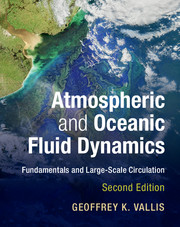Book contents
- Frontmatter
- Dedication
- Contents
- Preface
- Notation
- PART I FUNDAMENTALS OF GEOPHYSICAL FLUID DYNAMICS
- 1 Equations of Motion
- 2 Effects of Rotation and Stratification
- 3 Shallow Water Systems
- 4 Vorticity and Potential Vorticity
- 5 Geostrophic Theory
- PART II WAVES, INSTABILITIES AND TURBULENCE
- PART III LARGE-SCALE ATMOSPHERIC CIRCULATION
- PART IV LARGE-SCALE OCEANIC CIRCULATION
- References
- Index
5 - Geostrophic Theory
from PART I - FUNDAMENTALS OF GEOPHYSICAL FLUID DYNAMICS
Published online by Cambridge University Press: 09 June 2017
- Frontmatter
- Dedication
- Contents
- Preface
- Notation
- PART I FUNDAMENTALS OF GEOPHYSICAL FLUID DYNAMICS
- 1 Equations of Motion
- 2 Effects of Rotation and Stratification
- 3 Shallow Water Systems
- 4 Vorticity and Potential Vorticity
- 5 Geostrophic Theory
- PART II WAVES, INSTABILITIES AND TURBULENCE
- PART III LARGE-SCALE ATMOSPHERIC CIRCULATION
- PART IV LARGE-SCALE OCEANIC CIRCULATION
- References
- Index
Summary
LARGE-SCALE FLOW IN THE OCEAN AND THE ATMOSPHERE is characterized by an approximate balance in the vertical direction between the pressure gradient and gravity (hydrostatic balance), and in the horizontal direction between the pressure gradient and the Coriolis force (geostrophic balance). In this chapter we exploit these balances to simplify the Navier–Stokes equations and thereby obtain various sets of simplified ‘geostrophic equations’. Depending on the precise nature of the assumptions we make, we are led to the quasi-geostrophic (QG) system for horizontal scales similar to that on which most synoptic activity takes place and, for very large-scale motion, to the planetary-geostrophic (PG) set of equations. By eliminating unwanted or unimportant modes of motion, in particular sound waves and gravity waves, and by building in the important balances between flow fields, these filtered equation sets allow the investigator to better focus on a particular class of phenomena and to potentially achieve a deeper understanding than might otherwise be possible.
Simplifying the equations in this way relies first on scaling the equations. The idea is that we choose the scales we wish to describe, typically either on some a-priori basis or by using observations as a guide. We then attempt to derive a set of equations that is simpler than the original set but that consistently describes motion of the chosen scale. An asymptotic method is one way to achieve this, for it systematically tells us which terms we can drop and which we should keep. The combined approach — scaling plus asymptotics — has proven enormously useful, but we should always remember two things: (i) that scaling is a choice; (ii) that the approach does not explain the existence of particular scales of motion, it just describes the motion that might occur on such scales. We have already employed this general approach in deriving the hydrostatic primitive equations, but now we go further.
GEOSTROPHIC SCALING
Scaling in the Shallow Water Equations
Postponing the complications that come with stratification, we begin with the shallow water equations.
- Type
- Chapter
- Information
- Atmospheric and Oceanic Fluid DynamicsFundamentals and Large-Scale Circulation, pp. 171 - 212Publisher: Cambridge University PressPrint publication year: 2017
- 1
- Cited by



